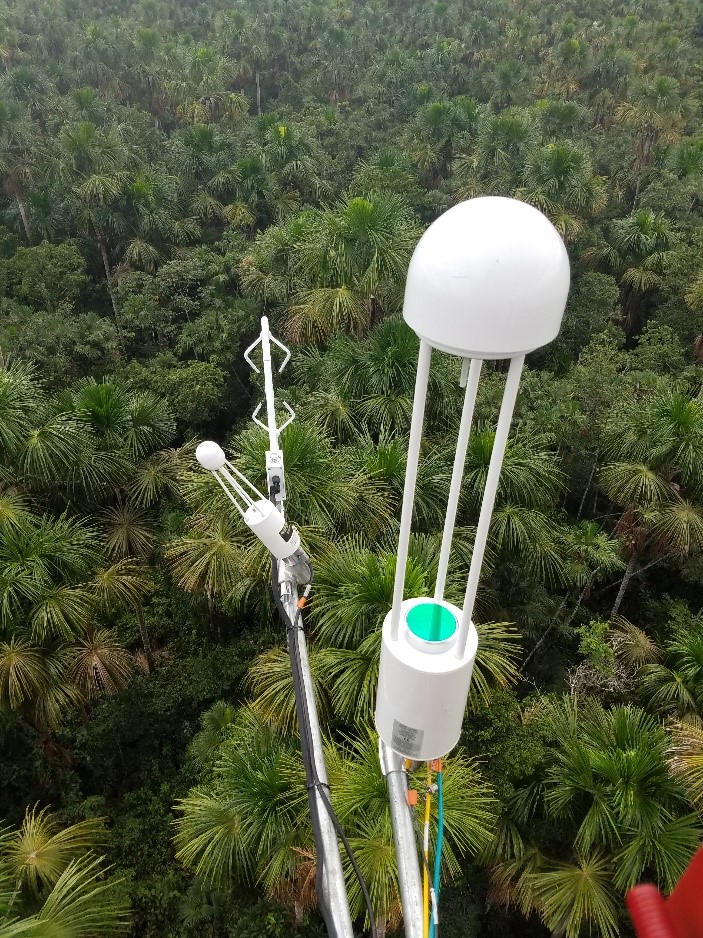December 15, 2020
Amazonian Palm Swamp Forests Are a Large Carbon Dioxide Sink and Methane Source
Amazonian palm swamp forests are important carbon sinks, but evidence indicates the sink strength is vulnerable to future warmer and drier conditions.

Eddy covariance measurements of carbon dioxide and methane above an Amazonian palm swamp forest peatland.
[Photo by Tyler Roman, USDA-Forest Service.]
The Science
Tropical peatlands are a major, but understudied, biophysical feedback factor on the atmospheric greenhouse effect. To address this knowledge gap, the research team established an eddy covariance flux tower in a natural palm swamp peatland near Iquitos, Peru to improve the understanding of how these forested peatlands exchange carbon dioxide and methane with the atmosphere over a two-year period. The land-atmosphere carbon fluxes indicated that the peatland was a significant carbon dioxide sink but a methane source under current conditions, but evidence indicates that the sink strength is vulnerable to future climate change.
The Impact
Recent modeling studies suggest that Amazonian peatlands play an important role in the global methane budget and are highly sensitive to climate change. Here, the team provide some of the first ecosystem scale observations to help provide a better biophysical understanding of the role that these Amazonian palm swamp peatlands play in carbon cycling. Study observations and analyses will be important for constraining models that aim to scale up the carbon budget for this region and will be critical for understanding how sensitive carbon dioxide (CO2) and methane CH4) emissions are to interannual variability in climate and hydrology.
Summary
This study reports ecosystem-scale CO2 and CH4 flux observations for an Amazonian palm swamp peatland over a two-year period in relation to hydrometeorological forcings. Seasonal and short-term variations in hydrometeorological forcing had a strong effect on CO2 and CH4 fluxes. High air temperature and vapor pressure deficit exerted an important limitation on photosynthesis during the dry season, while latent heat flux appeared to be insensitive to these climate drivers. Evidence from light-response analyses and flux partitioning support that photosynthetic activity was downregulated during dry conditions, while ecosystem respiration was either inhibited or enhanced depending on water table position. The cumulative net ecosystem carbon dioxide exchange indicated that the peatland was a significant carbon dioxide sink ranging from –465 (–279 to –651) g C m–2 y–1 in 2018 to –462 (−277 to −647) g C m–2 y–1 in 2019. The forest was a methane source of 22 (20 to 24) g C m–2 y–1, similar in magnitude to other tropical peatlands and larger than boreal and arctic peatlands. Thus, this Amazonian palm swamp peatland appears to be a major carbon sink and to drive net negative radiative forcing under current hydrometeorological conditions, but evidence indicates that the sink strength is vulnerable to future climate change.
Principal Investigator
Tim Griffis
University of Minnesota
timgriffis@umn.edu
Program Manager
Daniel Stover
U.S. Department of Energy, Biological and Environmental Research (SC-33)
Environmental System Science
daniel.stover@science.doe.gov
Funding
This research is based on work supported by:
- U.S. Department of Energy Office of Science, Office of Biological and Environmental Research, Terrestrial Ecosystem Science Program, under Award Number DE-SC0020167.
- U.S. Department of Energy Office of Science, Office of Biological and Environmental Research Program, Oak Ridge National Laboratory’s Terrestrial Ecosystem Science‐Science Focus Area; ORNL is managed by UT‐ Battelle, LLC, for the U.S. Department of Energy under contract DE‐AC05‐00OR22725.
- U.S. interagency SilvaCarbon program and the Sustainable Wetlands Adaptation and Mitigation Program (SWAMP) program. SilvaCarbon is funded by the U.S. Agency for International Development (USAID) and U.S. Department of State, and is implemented by the USDA Forest Service (USFS) and U.S. Geological Survey. SWAMP is funded by USAID and implemented by USFS and the Center for International Forestry Research.
- U.S. National Science Foundation under Grant No 1355066.
- The Instituto de Investigaciones de la Amazonía Peruana (IIAP).
Related Links
References
Griffis, T. J., D. T. Roman, J. D. Wood, and J. Deventer, et al. "Hydrometeorological sensitivities of net ecosystem carbon dioxide and methane exchange of an Amazonian palm swamp peatland." Agricultural and Forest Meteorology 295 (108167), (2020). https://doi.org/10.1016/j.agrformet.2020.108167.

